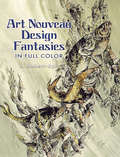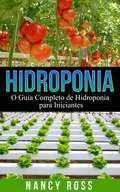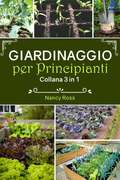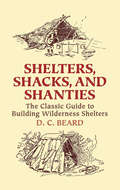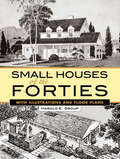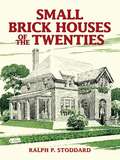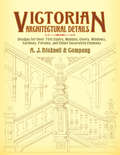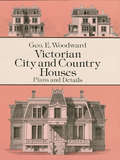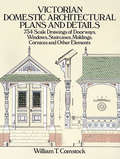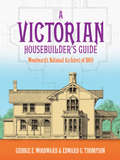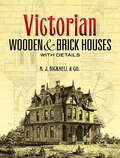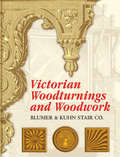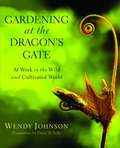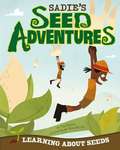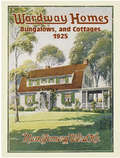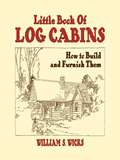- Table View
- List View
Art Deco: Design Fantasies
by E. H. RaskinDerived from a rare French publication of the 1920s, Fantaisies Oceanographiques, these beguiling images pulse with the flowing grace of aquatic life. The 30 full-color plates feature 56 abstract and figurative patterns in authentic Art Deco style. Whether simply browsed for pleasure or as a source of ideas for design or decorative projects, these playful images of marine plants and animals offer a wealth of inspiration.
Art Nouveau Design Fantasies in Full Color
by J. Habert-DysElegant and distinctive, these eye-catching motifs combine a refined naturalism with the sophistication of Art Nouveau. Created during the early years of Art Nouveau, they reflect the late nineteenth century interest in Japanese art, as well as the fresh excitement of a blossoming movement that's remained fashionable for well over a century.Sixty-six full-color images feature luxurious patterns and ornaments designed for ceramics, furniture, textiles, walls, and ceilings. Superbly reproduced from a rare folio, these decorations were formerly available only in high-priced antiquarian editions. This inexpensive compilation makes them readily accessible and royalty-free to graphic artists, crafters, and designers.
Engraving Glass: A Beginner's Guide
by Boyd Graham"Lucidly written and illustrated." — The Glass EngraverIf you've ever admired the exquisite beauty and craftsmanship of Steuben, Tiffany, Orrefors, or other fine engraved glass and wished you could engrave glass yourself, this book is for you. It provides step-by-step instructions for diamond-bur engraving, from making the first cut to displaying the finished work.The author, a prize-winning engraver, provides a detailed summary of tools and equipment you will need and suggestions for setting up your workshop, along with easy-to-follow practice exercises to give you a feel for working with glass and glass-engraving equipment. Mr. Graham then guides students through four complete projects, ranging from a simple tree design to a more complex flower engraving.Here are other practical features that make this book ideal for the novice: a useful discussion of design considerations and applications, review of supplemental tools and advanced techniques, expert advice on choosing glass, suggestions for the arrangement and lighting of finished pieces, and more. Over 100 helpful illustrations enhance the text.With this inexpensive book as your guide, you'll find learning the fundamentals of glass engraving far easier than you might have imagined. Simply written and easy to understand, Engraving Glass: A Beginner's Guide is your personal invitation to enjoy the challenges and satisfactions of this rewarding craft.
Hidroponia: O Guia Completo de Hidroponia para Iniciantes
by Nancy RossO livro nos mostra as vantagens do uso dos sistemas hidrôponicos como alternativa ao sistema tradicional de cultivo em solo. Apresenta de forma clara algumas técnicas e manejos, incluindo as ferramentas, criação de espaços, iluminação e cores apropriados para a obtenção dos melhores resultados nos cultivos.
A Alquimia das Ervas: Um Guia para Iniciantes - Conhecendo, cultivando e aplicando ervas medicinais.
by Adidas Wilson Rodrigo BrandaniAo selecionar ervas que consigam se desenvolver excepcionalmente bem, seja em ambientes abertos ou fechados, seja em vasos ou no solo, você deverá ter em mente o que você deseja obter de seu cultivo de ervas e vegetais. Se o espaço destinado ao seu cultivo recebe menos do que cinco horas diárias de luz solar talvez seja melhor plantar suas ervas em um ambiente fechado, e para agua-las e para colhê-las quando for cozinhar usando elas. Aliás, plantar em um ambiente fechado ainda lhe ajudará a ficar livre de ervas daninhas, pragas e variações de temperatura. Sementes são baratas, porém, demoram muito tempo para crescer demandam muitos recursos para fazê-lo. Por outro lado, existem as mudas, que crescem mais rapidamente, porém, geralmente encontram-se disponíveis somente na primavera e no verão. Muitas ferramentas são necessárias para se fazer o trabalho na sua plantação, dentre elas temos: pás, enxadas, luvas, vasos, enfim, tudo o que for necessário para fazer o serviço. Lembre-se de que solo fértil também é um elemento importante, pode-se prepara-lo naturalmente ou compra-lo pronto em lojas especializadas. Caso opte por fazer seu cultivo em um espaço fechado utilizando vasos você pode comprar misturas de adubos prontos, feitos especialmente para este tipo de cultivo, assim não terá problemas para plantar suas ervas, e, além de facilitar seu trabalho, estes adubos prontos também previnem que pragas destruam suas plantas.
Giardinaggio per principianti: Collana 3 in 1
by Nancy Ross Domenico Di NoiVUOI IMPARARE TUTTI I SEGRETI DEL GIARDINAGGIO PER I PRINCIPIANTI? Ecco Un'Anteprima Di Quello che Imparerai Riguardo Al Giardinaggio In Vaso... Acquistare i Vasi per il Tuo Giardino Creare l’Ambiente Adatto alle tue Piante in Vaso Scegliere il Periodo Adatto per Piantare Le Migliori Piante da Coltivare in Vaso Consigli per far Crescere Rigogliose le tue Piante Molto, molto ancora!
Guia para Jardinagem e Flores
by Agatha Albright Beatriz dos Santos MaranhoGuia de Jardinagem: Cultivar, Plantar, Crescer, e Manter Lindos Espaços Externos Durante Todas as Estações Agatha Albright te ensinará a planejar um maravilhoso jardim de flores para todas as estações do ano. - Prepare, cultive, colha e organize lindos arranjos florais para deixar seu gramado deslumbrante! - Prepare o espaços ideal para o cultivo de suas flores. - Cultive durante todas as estações do ano. - Cultive em todos os tipos de espaços. - Aprenda sobre os tipos mais impressionates de plantas. - Passo a passo
Como Organizar Sua Casa e Mente: A Arte de Arrumar, Limpar e Remover Bagunças de Sua Vida
by Beatriz dos Santos Maranho Mary AlbrichVoce sente como se seus esforcos para manter sua casa ou espacos pessoais organizados sao ineficazes? Mary eleva os parametros de limpeza e organizacao com sue novo livro. Este guia detalhado é um método rápido, fácil e eficiente para limpar sua casa ou espaços pessoais. Esses passos permitirão que você remova a desordem interminável da sua vida, limpe sua mente e torne-se mais eficiente, sentindo-se menos estressado e mais feliz!
Authentic Color Schemes for Victorian Houses: Comstock's Modern House Painting, 1883
by E. K. Rossiter F. A. WrightWhen the authors, a pair of respected architects, first published this beautiful book in the late Victorian era, they meant it as a wakeup call to the forward-looking homeowners of the time — inviting them to eschew "the old puritanical hatred of color, which found its natural outcome in white houses with green blinds" and join in the revolutionary trend toward "advanced notions, in which the more positive colors find a chance of expression." The book helped homeowners to attain this goal through its presentation of full-color illustrations of attractive, up-to-date color schemes for houses, with special attention given to the refined lines of Queen Anne-style homes.The heart of the book is the section of 20 exquisite color plates — each reproducing a flawlessly executed architectural drawing that shows the color possibilities for a specific house, and each accompanied by an extensive written description of the colors to be used for exterior walls and trim. An informative introductory section gives a clear explanation of how to mix primary and secondary colors to achieve such popular, mellow tones of the period as olive, russet, citrine, buff, plum, and sage. This authentic source of inspiration and suggestions will be prized by restorationists, architects, home-builders, and lovers of Victoriana.
Shelters, Shacks, and Shanties: The Classic Guide to Building Wilderness Shelters
by D. C. BeardThis excellent hands-on guide by one of the founders of the Boy Scouts of America contains a wealth of practical instruction and advice on how to build everything from a bark teepee and a tree-top house to a log cabin and a sod house. No professional architects are needed here; and knowing how to use an axe is more important than possessing carpentry skills. More than 300 of the author's own illustrations and a clear, easy-to-follow text enable campers to create such lodgings as half-cave shelters, beaver mat huts, birch bark shacks, over-water camps, a Navajo hogan, and a pole house. <p><p> Additional chapters provide information on how to use an axe, split and notch logs, make a fireplace, and even build appropriate gateways to log houses, game preserves, ranches, and other open areas. An invaluable book for scouts, campers, hikers, and hunters of all ages, this guide and its fascinating collection of outdoor lore "still has intrinsic value," said Whole Earth Magazine, and will be of keen interest to any modern homesteader.
Small Houses of the Forties: With Illustrations and Floor Plans
by Harold E. GroupDesigned for the 1940s family with a "limited budget but unlimited good taste," this fascinating volume presents 56 floor plans and elevations of lovely small homes that originally cost less than $15,000 to build. Each home, bearing the honorable designation of House-of-the-Month by the era's Monthly Small House Club, Inc., was designed to give prospective homeowners an exceptionally well-planned house that was also a sound investment. From Cape Cods to Colonials, Small Houses of the Forties offers an eden of illustrations of cozy, charming domiciles, complete with color combinations, charts, and diagrams. This complete republication of a now-rare volume is also filled with vintage dollars-and-sense information for the postwar homebuyer, including mortgage guidance, amortization schedules, valuations, and construction costs of the times. <p><p> A nostalgic flashback to a simpler American dream of white picket fences, this entertaining and valuable reference will delight architecture enthusiasts, plan collectors, restorers, and historians alike.
Small Brick Houses of the Twenties
by Ralph P. StoddardOnce affordable only among the wealthy, brick homes became more easily available to the average American in the early years of the twentieth century. This book, originally published in 1920 by a member of The Common Brick Manufacturers' Association, served as a practical guide for prospective homeowners from working class families. Many soon found that attractive, durable, and comfortable homes--made from nature's own building material--were easily within their financial reach. <p><p> Thirty-five sets of floor plans, elevations, and specifications in this excellent reproduction of that now-rare volume depict a wide variety of brick houses, bungalows, cottages, garages, and multi-dwelling buildings--from the four-bedroom Pocatello to the handsome Saratoga, featuring a wraparound porch and two bathrooms. This practical guide will appeal to anyone wanting to buy or renovate an existing home of the period. It will also serve as a how-to manual for all desiring to build their own homes today with authentic materials and techniques. For those who love fine, old buildings, Small Brick Houses of the Twenties offers a charming view of American homes from that era.
Victorian Architectural Details: Designs for Over 700 Stairs, Mantels, Doors, Windows, Cornices, Porches, and Other Decorative Elements
by Co. A. J. BicknellHundreds of rare illustrations depict wide range of design alternatives for prospective homeowners and other customers of the late 19th century. While the collection includes elevations and floor plans for a variety of handsome, private residences and commercial structures, the emphasis is on architectural details — from dormer windows to balconies.
Victorian City and Country Houses: Plans and Details
by Geo E. WoodwardThe widespread interest in constructing and restoring Victorian homes makes this a must-have volume for today's builders, homeowners, architects, and preservationists. It offers an abundance of authentic, finely detailed plans and designs for a variety of Victorian residences.Included are 100 front and side elevations, floor plans, and original designs -- all to working scale -- for a block of five city houses, a country house with a French roof, a summer house, various styles of cottages, a tool house, and other buildings. The plates also depict a wealth of details: roof and dormer windows, balustrades, iron fences and gates, finials, crestings, gables, brackets, paneling, mantels, front doors, an oriel window, chimneys, and many other elements.Republished directly from a rare 1877 edition, the book offers a wonderfully authentic look back to the distinctive building styles of the Victorian period. It will not only delight builders and restorationists, but any student or lover of period architecture.
Victorian Domestic Architectural Plans and Details: 734 Scale Drawings of Doorways, Windows, Staircases, Moldings, Cornices, and Other Elements (Dover Architecture)
by William T. ComstockVictorian architecture, with its quirky diversity, eclectic origins, and exuberant ornamentation, continues to exert a strong attraction on today's architects, builders, and homeowners. For those interested in restoring, preserving, or even re-creating Victorian homes, authentic plans and designs are invaluable. This volume, meticulously reproduced from a rare nineteenth-century publication, offers an exceptionally rich pictorial record of actual mid- to late-Victorian designs.Extremely clear and detailed engravings — drawn to scale — present elevations, floor plans, perspectives, and other drawings (in some cases, complete framing plans) for country houses and cottages in a variety of styles: Queen Anne, Eastlake, Elizabethan, Colonial, Jacobean, Southern, Californian, and more. There are even designs for several store and office fronts, with counters, shelving, etc.Supplementing the large number of complete designs are nearly 700 large-scale drawings of virtually every architectural detail, many embodying the unique "gingerbread" that characterizes Victorian buildings. Included are clear, precise renderings of balusters, brackets, dormers, fireplaces, finials, gables, mantels, moldings, newels, porches, rafters, rosettes, staircases, transoms, verandahs, wainscoting, windows, and hundreds of other features.Restorers of old houses, preservationists, students of American architectural history, admirers of Victoriana, and anyone interested in the Victorian Gothic styles that dominated American domestic architecture in the late 1800s will want to have this inexpensive treasury of authentic century-old plans and details.
A Victorian Housebuilder's Guide: Woodward's National Architect of 1869 (Dover Architecture)
by Edward G. Thompson George E. WoodwardHere are detailed drawings, floor plans, elevations, specifications, and vintage cost estimates for twenty distinctive Victorian structures, ranging from a humble cottage to an ornate brick villa. They have been reproduced from a rare 1869 publication of Woodward's National Architect, a publication directed to builders, carpenters, and masons of the Victorian era.Each of these highly individual and appealing structures has been meticulously rendered in a landscaped perspective view along with front and side elevations, first- and second-floor plans, and close-up sections. With more than 580 black-and-white illustrations, the text provides directions for finishing trim, baseboards, and wainscoting; completing brick and plaster work; constructing chimneys, cesspools, and cisterns; and much more. With its wealth of authentic detail, A Victorian Housebuilder's Guide is a valuable resource for restorers, preservationists, builders, and anyone interested in the era's architecture.
Victorian Wooden and Brick Houses with Details
by Co. A. J. BicknellThis vintage volume offers a treasure trove of floor plans, elevations, and details of residences and public buildings. Artists, architects, and historians alike will find it an endless source of inspiration.Featured buildings include villas, cottages, and farm houses as well as churches, schools, banks, and many other structures. Eighty-one remarkably detailed illustrations capture the elaborate, distinctive beauty of Victorian-era cornices, staircases, gables, verandas, doors, dormers, and other architectural elements. In addition, a fascinating "Specifications" section highlights construction guidelines for masons, bricklayers, and carpenters.
Victorian Woodturnings and Woodwork (Dover Architecture)
by Blumer Kuhn Stair Co.Reproduced from a rare original, this 1893 catalog offers nearly 800 detailed and authentic illustrations of superior-quality woodturnings and woodwork. In addition to its conventional examples, it features varied and unusual models of the Victorian style, including stairs, stair railings and balusters, and newel posts; mantels; turned porch and veranda work; gables and window hoods; ventilators; rosettes and other wooden ornaments; and moldings and interior finish.An excellent guide for woodturners and cabinetmakers, this volume also provides an inspiring and instructive resource for architects, preservationists, designers, and students of Victoriana.
Gardening at the Dragon's Gate: At Work in the Wild and Cultivated World
by Wendy Johnson Davis Te Selle<p>Gardening at the Dragon's Gate is fundamental work that permeates your entire life. It demands your energy and heart, and it gives you back great treasures as well, like a fortified sense of humor, an appreciation for paradox, and a huge harvest of Dinosaur kale and tiny red potatoes. <p>For more than thirty years, Wendy Johnson has been meditating and gardening at the Green Gulch Farm Zen Center in northern California, where the fields curve like an enormous green dragon between the hills and the ocean. Renowned for its pioneering role in California's food revolution, Green Gulch provides choice produce to farmers' markets and to San Francisco's Greens restaurant. Now Johnson has distilled her lifetime of experience into this extraordinary celebration of inner and outer growth, showing how the garden cultivates the gardener even as she digs beds, heaps up compost, plants flowers and fruit trees, and harvests bushels of organic vegetables. <p>Johnson is a hands-on, on-her-knees gardener, and she shares with the reader a wealth of practical knowledge and fascinating garden lore. But she is also a lover of the untamed and weedy, and she evokes through her exquisite prose an abiding appreciation for the earth--both cultivated and forever wild--in a book sure to earn a place in the great tradition of American nature writing.</p>
Better Homes and Gardens Kitchen and Bath Renovation Guide (Better Homes and Gardens Home)
by Better Homes and GardensThis essential resource will walk homeowners through the decision-making process for a kitchen or bath renovation to create the perfect space This indispensable reference covers everything homeowners need to know about making over the two rooms that yield the most resale value. Information is included for all stages of a kitchen or bath remodel, from inspiring before-and-after images to tips on getting started, with easy-to-read lists and sidebars on topics such as setting a budget and hiring professionals. Chapters highlight floor plan ideas, decorating styles, storage solutions, and lifestyle design choices. Plus, a handy shopping guide helps renovators choose key products, from kitchen cabinetry and cooktops to bathroom sinks and lighting. Complete with an appendix of checklists, this go-to guide is perfect for homeowners ready to update their spaces as well as those just looking for new ideas for renovations in the future.
Sadie's Seed Adventures: Learning About Seeds
by Tina DybvikSadie and Gardener Marv set out to clear weeds from a garden plot. While working, they go on a magical adventure to learn all about seeds. From hitching a ride with a cocklebur to flying through the sky with a milkweed seed, join Sadie as she figures out how seeds disperse.
Wardway Homes, Bungalows, and Cottages, 1925 (Dover Architecture)
by Montgomery Ward Co.Meticulous reproduction of a rare catalog includes floor plans as well as exterior and interior views of 80 American homes, among them a handsome, three-story frame residence with six bedrooms and a cozy, three-room cottage measuring 18 feet by 22 feet. 94 black-and-white illustrations depict handsome stairways, French doors, and other amenities.
Midcentury Christmas Stocking Stuffer Edition (Stocking Stuffer Edition)
by Sarah ArcherA celebration of (vintage) Christmas past Midcentury America was a wonderland of department stores, suburban cul-de-sacs, and Tupperware parties. At Christmastime, postwar America’s dreams and desires were on full display, from shopping mall Santas to shiny aluminum Christmas trees, from the Grinch to Charlie Brown’s beloved spindly Christmas tree. With more than 100 colorful illustrations and iconic designs, Sarah Archer celebrates the turning point of Christmas in America, when new technologies and unprecedented prosperity made anything seem possible. Midcentury Christmas is sure to be on everyone’s wish lists.
Little Book of Log Cabins: How to Build and Furnish Them
by William S. WicksOver a century ago, when he first wrote this little guide, William Sydney Wicks (1854–1919) whimsically observed that while early man lived in nature out of necessity, modern man has taken to the woods by choice. Wicks was a highly successful architect whose imprint can still be seen throughout Buffalo, New York, in dozens of churches, hotels, libraries, houses, and other structures. For several years, he was also Buffalo's park commissioner. Wicks' lovely little how-to manual—complete with simple diagrams and step-by-step details—is the ideal dream book for people who think of someday building their own rustic cottage. It's a charming repository of practical shelters and make-it-yourself log furnishings that will inspire every home craftsman and everyone who yearns to get back to nature. Building instructions are accompanied by clear, accurate line drawings of simple log structures, lean-tos, fancy Adirondack cabins, fireplaces, stairways, furniture, beamed ceilings, and much more. A perfect guide for anyone who loves the outdoors, the Little Book of Log Cabins will provide a feast for browsing and for practical projects.

